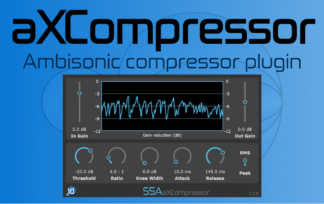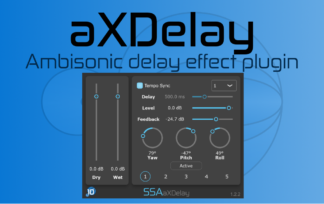Ambisonics for Audiences
This project page contains some of the results from my PhD thesis and scientific articles that I have published.
When Ambisonics is played back over loudspeakers (as opposed to binauralised over headphones) only one person can sit in the sweet spot. This means everyone else in the audience will be sitting closer to some loudspeakers than others. This causes the auditory system to begin to treat the signals from the more distant loudspeakers as echoes, supressing their contribution to the perceived source direction. This sucks the sound to the nearer side of the loudspeaker array. This happens with all amplitude panning systems (stereo, VBAP, MDAP etc.) so it is worth trying to understand it!
We’ll need some way of looking at the quality of the rendering inside the whole listening area. What we’ll be using is an extended version of the energy vector that includes psychoacoustic factors (localisation dominance, the precedence effect, Haas effect, etc.). The basic energy vector uses the loudspeakers energies and their direction relative to the listener to predict where a listener will hear the sound.
My paper setting out the extended energy vector model in detail can be found in the eLibrary of the Audio Engineering Society (here). You can down the MATLAB code for the extended energy vector here.
First, let’s consider first-order Ambisonics system (2D playback for now). Illustrations will be done with a max rE decoder since this kind gives the best results for off-centre listeners.
Since it’s first-order we only need to use 4 loudspeakers to place the sound at any angle around the listener. The video shows the predicted direction in which the source will be perceived for a listener at different grid points in the listening area.
We can see that the perceived sound direction (indicated by the arrow directions) is sucked to the loudspeakers (black dots) nearest to the listener. This effect can be quite strong even for small displacements from the sweet spot.
But what if we add more loudspeakers? The video to the right shows a first-order decoder to eight loudspeakers in an octagon.
We can see that there the error patterns are different to the four-speaker case but not necessarily better. For example, with 4 speakers there are large areas of low error – almost a quarter of the listening area – when the sound is directly in one of the loudspeaker positions. With the eight-speaker case this doesn’t happen.
Both first-order setups show the sound being pulled very strongly in the direction of the nearest loudspeakers.
So what if we keep eight speakers and increase the order of the Ambisonics playback?
The error decreases significantly for large portions of the listening area, especially on the far side of the loudspeaker array. The image is still clearly pulled to the nearest loudspeakers to the listener, but generally only for those around the sound position.
This shows the benefit of increasing the Ambisonic order as high as possible when you are presenting a sound scene to an audience. There is some evidence that this is less critical for signals that include Ambisonically rendered rooms and the benefit of increasing the order is smaller. It’s still recommended to use the highest possible order for any given loudspeaker array.










